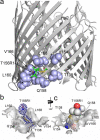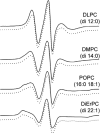Molecular origin of electron paramagnetic resonance line shapes on β-barrel membrane proteins: the local solvation environment modulates spin-label configuration
- PMID: 21894979
- PMCID: PMC3199607
- DOI: 10.1021/bi200971x
Molecular origin of electron paramagnetic resonance line shapes on β-barrel membrane proteins: the local solvation environment modulates spin-label configuration
Abstract
In this work, electron paramagnetic resonance (EPR) spectroscopy and X-ray crystallography were used to examine the origins of EPR line shapes from spin-labels at the protein-lipid interface on the β-barrel membrane protein BtuB. Two atomic-resolution structures were obtained for the methanethiosulfonate spin-label derivatized to cysteines on the membrane-facing surface of BtuB. At one of these sites, position 156, the label side chain resides in a pocket formed by neighboring residues; however, it extends from the protein surface and yields a single-component EPR spectrum in the crystal that results primarily from fast rotation about the fourth and fifth bonds linking the spin-label to the protein backbone. In lipid bilayers, site 156 yields a multicomponent spectrum resulting from different rotameric states of the labeled side chain. Moreover, changes in the lipid environment, such as variations in bilayer thickness, modulate the EPR spectrum by modulating label rotamer populations. At a second site, position 371, the labeled side chain interacts with a pocket on the protein surface, leading to a highly immobilized single-component EPR spectrum that is not sensitive to hydrocarbon thickness. This spectrum is similar to that seen at other sites that are deep in the hydrocarbon, such as position 170. This work indicates that the rotameric states of spin-labels on exposed hydrocarbon sites are sensitive to the environment at the protein-hydrocarbon interface, and that this environment may modulate weak interactions between the labeled side chain and the protein surface. In the case of BtuB, lipid acyl chain packing is not symmetric around the β-barrel, and EPR spectra from labeled hydrocarbon-facing sites in BtuB may reflect this asymmetry. In addition to facilitating the interpretation of EPR spectra of membrane proteins, these results have important implications for the use of long-range distance restraints in protein structure refinement that are obtained from spin-labels.
© 2011 American Chemical Society
Figures











Similar articles
-
Structure and dynamics of the beta-barrel of the membrane transporter BtuB by site-directed spin labeling.Biochemistry. 2002 Oct 1;41(39):11543-51. doi: 10.1021/bi0259397. Biochemistry. 2002. PMID: 12269798
-
Membrane hydrocarbon thickness modulates the dynamics of a membrane transport protein.Biophys J. 2008 Sep 15;95(6):2849-58. doi: 10.1529/biophysj.108.133629. Epub 2008 Jun 27. Biophys J. 2008. PMID: 18586842 Free PMC article.
-
Lipid and membrane mimetic environments modulate spin label side chain configuration in the outer membrane protein A.J Phys Chem B. 2011 Dec 15;115(49):14822-30. doi: 10.1021/jp207420d. Epub 2011 Nov 15. J Phys Chem B. 2011. PMID: 22034842 Free PMC article.
-
Identifying and quantitating conformational exchange in membrane proteins using site-directed spin labeling.Acc Chem Res. 2014 Oct 21;47(10):3102-9. doi: 10.1021/ar500228s. Epub 2014 Aug 25. Acc Chem Res. 2014. PMID: 25152957 Free PMC article. Review.
-
Toward the fourth dimension of membrane protein structure: insight into dynamics from spin-labeling EPR spectroscopy.Structure. 2011 Nov 9;19(11):1549-61. doi: 10.1016/j.str.2011.10.009. Structure. 2011. PMID: 22078555 Free PMC article. Review.
Cited by
-
The double-histidine Cu²⁺-binding motif: a highly rigid, site-specific spin probe for electron spin resonance distance measurements.Angew Chem Int Ed Engl. 2015 May 18;54(21):6330-4. doi: 10.1002/anie.201501968. Epub 2015 Mar 27. Angew Chem Int Ed Engl. 2015. PMID: 25821033 Free PMC article.
-
Complexin Binding to Membranes and Acceptor t-SNAREs Explains Its Clamping Effect on Fusion.Biophys J. 2017 Sep 19;113(6):1235-1250. doi: 10.1016/j.bpj.2017.04.002. Epub 2017 Apr 26. Biophys J. 2017. PMID: 28456331 Free PMC article.
-
The N-terminal domain of a TonB-dependent transporter undergoes a reversible stepwise denaturation.Biochemistry. 2012 May 1;51(17):3642-50. doi: 10.1021/bi300118a. Epub 2012 Apr 22. Biochemistry. 2012. PMID: 22497281 Free PMC article.
-
Mannose-Presenting "Glyco-Colicins" Convert the Bacterial Cell Surface into a Multivalent Adsorption Site for Adherent Bacteria.JACS Au. 2024 Jun 12;4(6):2122-2129. doi: 10.1021/jacsau.4c00365. eCollection 2024 Jun 24. JACS Au. 2024. PMID: 38938796 Free PMC article.
-
Beyond structure: Deciphering site-specific dynamics in proteins from double histidine-based EPR measurements.Protein Sci. 2022 Jul;31(7):e4359. doi: 10.1002/pro.4359. Protein Sci. 2022. PMID: 35762707 Free PMC article.
References
-
- Klug CS, Feix JB. Methods and applications of site-directed spin labeling EPR spectroscopy. Methods Cell Biol. 2008;84:617–658. - PubMed
-
- Jeschke G, Polyhach Y. Distance measurements on spin-labelled biomacromolecules by pulsed electron paramagnetic resonance. Physical Chemistry Chemical Physics. 2007;9:1895–1910. - PubMed
-
- Fanucci GE, Cafiso DS. Recent advances and applications of site-directed spin labeling. Curr Opin Struct Biol. 2006;16:644–653. - PubMed
-
- Hubbell WL, Cafiso DS, Altenbach C. Identifying conformational changes with site-directed spin labeling. Nat Struct Biol. 2000;7:735–739. - PubMed
-
- Hubbell WL, Gross A, Langen R, Lietzow MA. Recent advances in site-directed spin labeling of proteins. Curr Opin Struct Biol. 1998;8:649–656. - PubMed
Publication types
MeSH terms
Substances
Grants and funding
LinkOut - more resources
Full Text Sources

